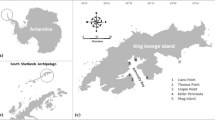Abstract
In biological systems, strontium (Sr) and barium (Ba) are two non-essential elements, in comparison to calcium (Ca) which is essential. The Sr/Ca and Ba/Ca ratios tend to decrease in biochemical pathways which include Ca as an essential element, and these processes are termed biopurification of Ca. The quantitative pathway of the biopurification of Ca in relation to Sr and Ba between two biological reservoirs (R n and R n -1) is measured with an observed ratio (OR) expressed by the (Sr/Ca) Rn /(Sr/Ca) Rn-1 and (Ba/Ca) Rn /(Ba/Ca) Rn-1 ratios. For a mammalian organism, during the whole biopurification of Ca starting with the diet to the ultimate reservoir of Ca which is the bone, the mean values for ORSr and ORBa are 0.25 and 0.2, respectively. In this study, published Sr/Ca and Ba/Ca ratios are used for three sets of soils, plants, and bones of herbivorous and carnivorous mammals, each comprising a trophic chain, to illustrate the biopurification of Ca at the level of trophic chains. Calculated ORSr and ORBa of herbivore bones in relation to plants and of bones of carnivores in relation to bones of herbivores give ORSr=0.30±0.08 and ORBa=0.16±0.08, thus suggesting that trophic chains reflect the Sr/Ca and Ba/Ca fluxes that are prevalent at the level of a mammalian organism. The slopes of the three regression equations of log(Sr/Ca) vs. log(Ba/Ca) are similar, indicating that the process of biopurification of Ca with respect to Sr and Ba is due to biological processes and is independent of the geological settings. Modifications of the logarithmic expression of the Sr/Ca and Ba/Ca relationship allow a new formula of the biopurification process to be deduced, leading to the general equation ORBa=ORSr 1.79±0.33,where the allometric coefficient is the mean of the slopes of the three regression equations. Some recent examples are used to illustrate this new analysis of predator-prey relations between mammals. This opens up new possibilities for the utilization of Ba/Ca and Sr/Ca in addition to stable isotope ratios (δ13C and δ15N) for the determination of the relative contribution of different food sources to an animal’s diet.







Similar content being viewed by others
References
Balter V, Person A, Labourdette N, Drucker D, Renard M, Vandermeersch B (2001) Les Néanderthaliens étaient-ils essentiellement carnivores? Résultats préliminaires sur les teneurs en Sr et Ba de la paléobiocénose mammalienne de Saint-Césaire. C R Acad Sci 332:59–65
Balter V, Bocherens H, Person A, Labourdette N, Renard M, Vandermeersch B (2002) Ecological and physiological variability of Sr/Ca and Ba/Ca in mammals of West European mid-Würmian food webs. Palaeogeogr Palaeoclimatol Palaeoecol 186:127–143
Ben-David M, Schell DM (2001) Mixing models in analyses of diet using multiple stable isotopic ratios: a response. Oecologia 127:180–184
Burnett MW, Settle DM, Patterson CC (1976) Comparative distributions of alkaline earths and Pb among tissues of marine plants and animals. Adv Mass Spectrom 7B:1697–1701
Burton JH, Price TD, Middleton WD (1999) Correlation of bone Sr/Ca and Ba/Ca due to biological purification of calcium. J Archaeol Sci 26:609–616
Comar CL, Russell L, Wasserman RH, Nold NL (1956) Strontium-calcium discrimination factors in the rat. Proc Soc Exp Med Biol 92:859–863
Comar CL, Russell L, Wasserman RH (1957) Strontium-calcium movement from soil to man. Science 126:485–496
Elias RW, Hirao Y, Patterson CC (1982) The circumvention of the natural biopurification of calcium along nutrient pathways by atmospheric inputs of industrial lead. Geochim Cosmochim Acta 46:2561–2580
Gilbert C, Sealy J, Sillen A (1994) An investigation of barium, calcium and strontium as palaeodietary indicators in the Southwestern Cape, South Africa. J Archaeol Sci 21:173–184
Hirao Y, Patterson CC (1974) Lead aerosol pollution in the High Sierra overrides natural mechanisms which exclude lead from a food chain. Science 184:989–992
Kobayashi E, Suzuki KT (1990) Biological discrimination between calcium and strontium in the kidney and bone of calcium-deficient growing rats. J Trace Elem Exp Med 3:327–336
Koch PL, Phillips DL (2002) Incorporating concentration dependence in stable isotope mixing models: a reply to Robbins, Hilderbrand and Farley. Oecologia 133:14–18
Knudsen E, Sandström B, Solgaard P (1996) Zinc, Cu and Mg absorption from a fiber-rich diet. J Trace Elem Med Biol 10:68–76
Lambert JB, Weydert-Homeyer JM (1993) The fundamental relationship between ancient diet and the inorganic constituents of bone as derived from feeding experiments. Archaeometry 35:279–294
Leggett RW (1992) Fractional absorption of ingested barium in adult humans. Health Phys 62:556–561
Marcus CS, Wassermann RH (1965) Comparison of intestinal discrimination between calcium47, strontium85 and baryum133. Am J Physiol 209:973–977
Phillips DL (2001) Mixing models in analyses of diet using multiple stable isotopes: a critique. Oecologia 127:166–170
Phillips DL, Koch PL (2002) Incorporating concentration dependence in stable isotope mixing models. Oecologia 130:114–125
Robbins CT, Hilderbrand GV, Farley SD (2002) Incorporating concentration dependence in stable isotope mixing models: a response to Phillips and Koch (2002) Oecologia 133:10–13
Sealy J, Sillen A (1988) Sr and Sr/Ca in marine and terrestrial foodwebs in the Southwestern Cape, South Africa. J Archaeol Sci 15:425–438
Sillen A, Kavanagh M (1982) Strontium and paleodietary research. Yearb Phys Anthropol 25:67–90
Sillen A, Lee-Thorp JA (1994) Trace elements and isotopic aspects of predator-prey relationships in terrestrial foodwebs. Palaeogeogr Palaeoclimatol Palaeoecol 107:243–255
Sips AJAM, Barto R, Netelenbos JC, Van der Vijgh WJF (1997) Preclinical screening of the applicability of strontium as a marker for intestinal calcium absorption. Am J Physiol 272:E422-E428
Taylor CM (1990) Review of the composition of experimental low Zn diets for humans. J Trace Elem Exp Med 3:307–317
Wasserman RH, Comar CL, Papadopoulou D (1957) Dietary calcium levels and retention of radiostrontium in the growing rat. Science 126:1180–1182
Acknowledgements
Many thanks are due to C. Lécuyer, E. Koga-Rose and B. Reynard and two anonymous reviewers for thoughtful comments and criticism of an earlier version of this manuscript. This work was supported by the CNRS programs PEH and ECLIPSE.
Author information
Authors and Affiliations
Corresponding author
Rights and permissions
About this article
Cite this article
Balter, V. Allometric constraints on Sr/Ca and Ba/Ca partitioning in terrestrial mammalian trophic chains. Oecologia 139, 83–88 (2004). https://doi.org/10.1007/s00442-003-1476-0
Received:
Accepted:
Published:
Issue Date:
DOI: https://doi.org/10.1007/s00442-003-1476-0




